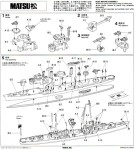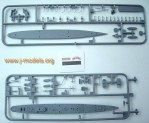

Hacía mucho años que Tamiya no renovaba su vieja serie de destructores japoneses de la serie Water Line de los años 70. No es que esta maqueta sea reciente, en realidad data de 1994, pero al menos es un molde nuevo, con mucho más detalle y mejor calidad general. Para el modelista es una suerte saber que a veces las grandes marcas no olvidan los modelos más humildes como este.
Básicamente, la nueva caja sigue incluyendo lo mismo que antaño: dos mínimas bandejas, las instrucciones y una hojita de calcas con la bandera, más una calca para representar las ventanas del puente de mando. En la parte posterior de la caja se nos muestra la planta y el perfil del buque con la referencia de color y los aparejos. Apostaría a que el número de piezas ha aumentado respecto al molde antiguo. Ahora trae nada menos que 62, y en principio uno no sabe si va a poder montarlas todas, ya que esta clase de destructores era de las más pequeñas de la Marina Imperial con sólo 98 metros de eslora. Increíblemente sí que caben en el reducido casco, aunque, dado el referente real, ya nos podemos imaginar el tamaño de la maqueta. Algo más ha cambiado, y es que no trae la usual barrita metálica de lastre, en su lugar la línea de flotación lleva agujeros marcados para abrirlos y sujetarla a una base.
Todo el modelo viene muy bien fabricado. El casco posee un relieve en cubierta excelente y en apariencia se ha conseguido representar hasta el más mínimo detalle. La artillería y los pescantes ya no tienen aquellas molestas rebabas que requerían tanta lija y paciencia, por eso no será imprescindible recurrir a un juego de mejora para sustituir estas piezas. A mí me sigue gustando más el acabado de PitRoad, especialmente en las ametralladoras simples de 25 mm., pero hay que reconocer que Tamiya ha hecho un esfuerzo en este aspecto. Sin embargo, las lanchas han perdido en detalle lo que han ganado en calidad. Su interior está hueco y no hay ni rastro de bancos para los ocupantes. Incluso habrá que comprobar si son realmente barcas de remos o lanchas a motor (lo más probable es que sean de ambos tipos), porque las que se incluyen no aparentan ni lo uno ni lo otro. Otro detalle mejorado son las anclas, que ya no aparecen grabadas en el casco como en tiempos, sino que son dos piezas sueltas.
El esquema de color es el usual gris de la Marina Imperial, aunque habría que buscar referencias sobre si algunas zonas de la cubierta iban pintadas de linóleo, pues la ilustración de la caja no ha sido tradicionalmente muy de fiar. Con todo, creo que lo mejor de esta maqueta es, aparte de su calidad, su montaje sencillo y se puede conseguir un acabado muy decente con sólo añadir unas barandillas. Muy recomendable para cualquier modelista aficionado a esta escala.◊

It has been a lot of time since Tamiya last issued their WL Series Japanese destroyers in the 70s. The fact is that this kit is not brand new stuff (it dates back from 1994), but at least it is a new tooling with more quality in detail. For the modeller it is good to know that big manufacturers do not always forget old nice kits like this.
The new box basically includes the same things: two small grey plastic sprues, the instructions and a tiny sheet with a flag and a striped decal for the bridge windows. There is the traditional picture on the back of the box showing a side view and the plant of the ship to use it as color and rigging reference. I’d bet the number of parts is greater than in the old tooling. Now there are no less than 62, and at first sight one seems unable to fit all of them onto the hull, (remember this destroyer class was one of the smallest in the Imperial Navy, only 98 meters long). According to the instructions they all seem to fit, although if you consider the size of the real ship, you can imagine the size of your model. There is another change from the old Matsu, you are not provided with the typical flat metal ballast. What you have instead is only the waterline hull with engraved holes for you to open them and fix the model to a base.
Parts are really finely molded and the hull has the least detail on the deck. Davits and AA guns no longer have that nasty flash that needed lots of sanding and patience and you will not have to resort to an upgrade set to replace them. I really prefer the Pit Road AA set, especially for the single 25 mm guns, but it is fair to say Tamiya have made an effort in this matter. However, the boats have lost in detail what they have been improved in quality. The interior is hollow and there is no trace of wooden seats. It is even advisable to check if they all were small boats or motor boats (probably both), because they do not look like any of them. The anchors have also been improved as they are included as separate parts, and not simply molded on the hull as it was usual.
The color scheme is the well-known IJN grey, although references should be checked to know whether some deck areas were painted in linoleum because the plant view on the box has not always been very reliable. All in all, I think the best thing of this Matsu is, apart from the quality, the ease of assembly. You can get a very nice model with only adding some railing. It is quite recommendable for any fan of this small scale.◊
Revisado – Revised: 9 / 2023
Actualizado – Updated: 4 / 2022
Actualizado – Updated: 5 / 2017
Publicado – Published: 9 / 2006
©www.jmodels.net




Debe estar conectado para enviar un comentario.